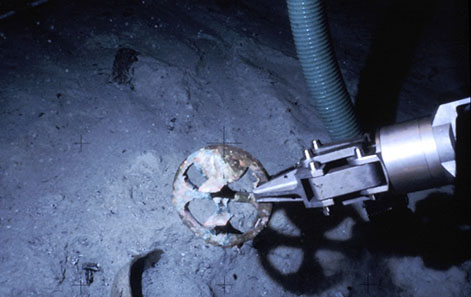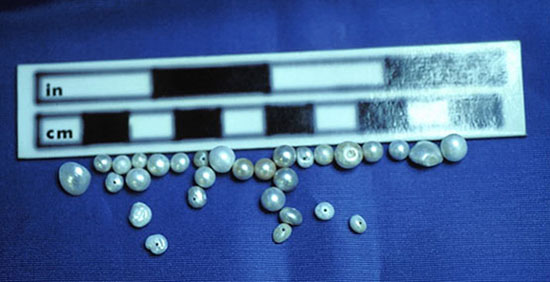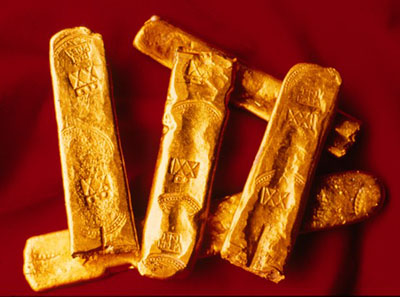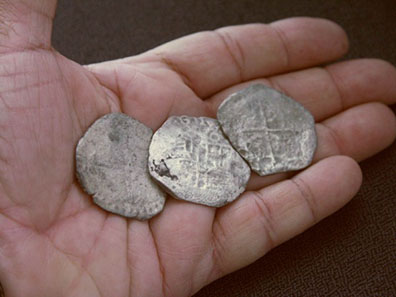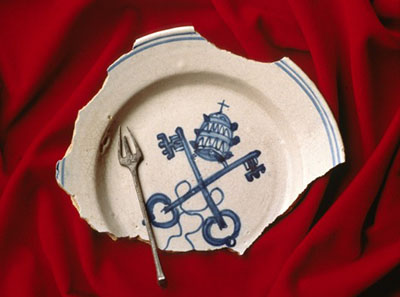by Björn Schöpe
June 27, 2013 – In 1989 in a depth of ca. 450m in the Straits of Florida a shipwreck was discovered which turned out to be part of the famous Spanish Treasure Fleet sunk in a hurricane in 1622. In these times Spain attended eagerly the arrival of enormous treasures transported by this fleet composed of more than 20 ships. The Spanish Crown was in acute financial problems and the loss of this fleet allegedly led the Bank of Madrid to break.
The ROV’s manipulator arm retrieves a rare bronze mariner’s astrolabe, one of three recovered from the 1622 Tortugas shipwreck site. Photo: Odyssey Marine Exploration, Inc., www.shipwreck.net.
Today we may understand better how much was lost because part of these treasures have been recovered. In 1990 and 1991 the private company Odyssey Marine Exploration conducted the excavation of the codenamed Tortugas shipwreck in 138 dives bringing over 16,0000 objects back from the sea-ground after 400 years.
Over 6,000 pearls were recovered from the “Tortugas” wreck site. As the result of abrasion, research suggests that the original pearls were two to three times their present size. Photo: Odyssey Marine Exploration, Inc., www.shipwreck.net.
Over 6,000 precious pearls of a particular kind of oyster nearly extinct already at this time …
Gold was the most coveted product in the new World. The “Tortugas” excavation yielded 27 gold bars, ranging from 20 to 22 karats. Photo: Odyssey Marine Exploration, Inc., www.shipwreck.net.
… and gold bars are only part of the cargo.
Over 1000 silver coins were found at the “Tortugas” wreck site Photo: Odyssey Marine Exploration, Inc., www.shipwreck.net.
Among this treasure there are also 1,184 silver coins containing no coins dated later than 1622. They are all of a type known as “cob” coins, a name derived from the Spanish phrase, Cabo de barra, meaning “end of the bar.” In the usual production process of cob coins, 92% to 98% pure silver was hammered into crude bars with slight variance in thickness. Pieces of the bar were then cut to approximate size, and the edges clipped until the blanks fell within specific weight requirements.
Evidence based on objects like the mentioned pearls suggests that the ship had sailed from Seville in Spain to Venezuela to stow precious materials and, of course, money and was hit being part of the Spanish Treasure Fleet, on her way back to Europe. The excavated ship was presumably the 117-ton vessel Buen Jesús Nuestra Señora del Rosario.
Spanish sailors of the seventeenth century were devoutly religious and the ship’s passenger lists often included Catholic clergy. A small brass medallion with religious figures on both sides is an especially prized piece recovered from the “Tortugas” wreck site. Photo: Odyssey Marine Exploration, Inc., www.shipwreck.net.
As for the importance of this excavation Greg Stemm, Odyssey Marine Exploration’s CEO, stated ‘The comprehensive archaeological excavation of the Tortugas shipwreck over 20 years ago paved the way for innovative advances in the methodology and robotic technology that we use to this day.’
‘This was one of the most important shipwreck finds of its time,’ Stemm said. ‘The archaeological world had long wondered what a colonial shipwreck would look like in the depths of the ocean, and whether it was possible to actually conduct archaeological fieldwork using robotics. Both these questions were answered by the Tortugas shipwreck. It was clear from the condition of this site that deep water shipwrecks were not going to be the perfectly preserved specimens that scientists had hoped for – unfortunately nature and trawlers caused significant damage even at those depths. The excavation team also proved that it was possible to conduct a sensitive archaeological excavation remotely with an archaeologist supervising ROV technicians.’
Among the glazed ceramic ware is a Sevilla Blue-on-White plate which has a “crossed keys and miter seal.” The design on the plate suggest the presence of a Catholic Church official on the ship. Photo: Odyssey Marine Exploration, Inc., www.shipwreck.net.
The DailyMail reported with many images on the recent finding.
Odyssey Marine Exploration presents material of this site internally codenamed ‘Tortuga’.
You can watch many of the Tortuga objects in Odyssey’s Virtual Museum.
Odyssey’s third book on a site, the Tortuga project, has been published with Oxbow Books.
There is also available online a detailed paper on the Tortuga project written by Odyssey experts.
We reported previously on the Shipwreck exhibition in New York.





